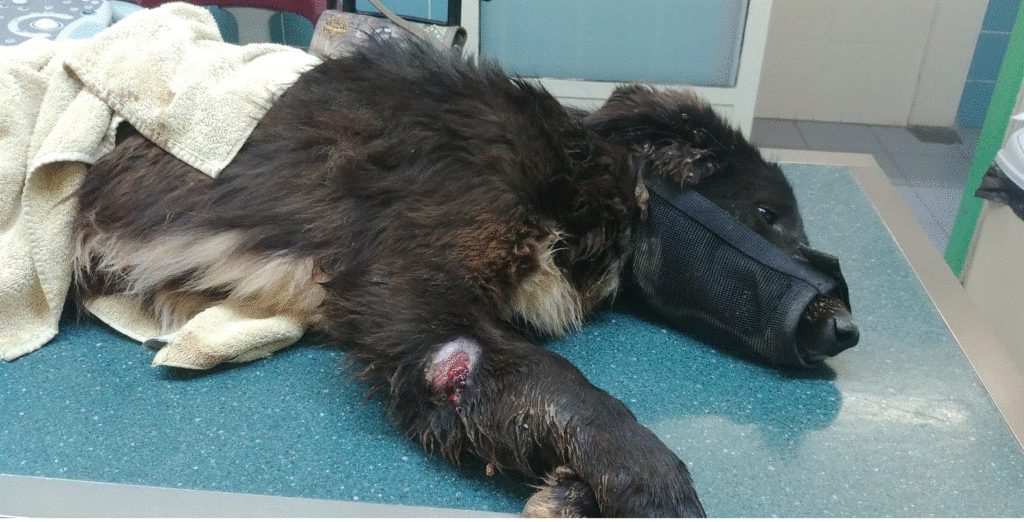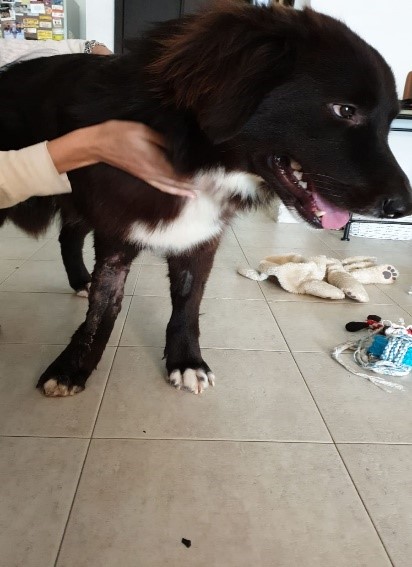On January 3rd, 2019, a passerby found a stray dog sitting in an awkward position on a sidewalk in an Israeli town. On closer inspection, he realized the dog’s leg was broken so badly the bone was sticking out the wound.

Shocked, the man called the local animal shelter for help. The dog, later named Freddie, was rushed to a nearby pet hospital. When doctors inspected the wound, they found multiple fractures surrounded by necrotic, infected tissue. Even more heartbreaking, they estimated that Freddie’s leg must have been broken for at least two weeks.
Sadly, such incidents are not rare. Both pets and wild animals frequently suffer wounds and injuries from vehicle hits, run-ins from other animals, or other causes. And, because animals can be really good at hiding their pain, it’s not uncommon for such wounds to go unnoticed for a long time.
There are many things you can do holistically to accelerate healing of wounds, minimize pain for the animal, reduce the stress of injury, and help animals recover faster. In this article, we’ll share a few of the holistic pet first aid and wound care treatments we’ve found most effective.
3 Natural Treatments for Pet First Aid and Wound Care
Emergency treatment of traumatic injuries such as broken bones and open wounds is one of the things conventional medicine is very good at. But in addition to standard pet first aid treatments, you can use the following suggestions to reduce stress and trauma and help your pet’s wound heal faster:
Bach Flower Essences –
These gentle natural formulas based on the work of 20th century English doctor Edward Bach help to balance the emotions, an important and often overlooked aspect of healing. While finding the right remedy takes skill and is best left to a practitioner, there are a couple of ready-made formulas that are worth having on hand:
- Rescue Remedy for Pets is an animal-specific version of combines five of the most effective flower essences for trauma into one formula. It is excellent to reduce shock at time of injury. During the wound healing process, you can add a few drops to your pet’s water dish or sprinkle them on a treat a few times a day. It will help keep your pet’s emotions level, so he can put his energy into healing his body instead of stressing out.
- Bach First Aid Remedy for Pets is based on the Rescue Remedy, with two additional flower essences added. It’s formulated to be used at times of severe stress, anxiety, or shock, so it’s a great addition to your pet first aid kit. Apply 4 drops directly to the tongue every 5 to 10 minutes until the animal is calm. As effective as they can be, flower essences are extremely gentle, so you don’t need to worry about overdosing your pet.
Homeopathy –
Like flower essences, homeopathic remedies work on the vibrational level and utilize extremely small doses of a substance to trigger a healing response in the body. Just like flower essences, it does take a lot of skill and training to find the right homeopathic remedy.
While most homeopathic remedies must be too carefully matched to symptoms to recommend as a general wound care treatment, one remedy that you might want to consider keeping on hand for emergencies is arnica montana. Arnica is excellent for relieving the bruising and soreness that may accompany an injury. When administered as soon as possible after an injury it can significantly reduce the extent of bruising as well as healing time
The best way to use arnica for pets is to purchase the homeopathic pellets and follow package directions. These can be placed in your pet’s mouth directly (if he can’t swallow, put them between his lip and gum and let them dissolve) or dissolved in a little water and given that way. (CAUTION: Arnica is also available as a topical cream. This is toxic when ingested so don’t use it on animals if there’s any chance they will lick it off. Also, arnica should NEVER be used on an open wound.)
Herbal Medicine –
There are many, many herbal remedies that can be used to aid in the healing of wounds and injuries. A few that are safe to use for pets include:
- Calendula – Also known as pot marigold, this popular garden plant has pain relieving and antimicrobial properties. Sprays, salves, and ointments are readily available over the counter. Calendula is safe to use on pets and makes an excellent addition to your pet first aid kit.
- Comfrey – Another name for this healing herb is “bone knit,” which speaks for itself. Used topically in a poultice or salve, it is well known for its ability to accelerate tissue healing, including helping bones to set faster.
- Nettle – Don’t worry, we’re not telling you to put stinging nettle on your pet’s wounds! Nettle is an excellent general tonic and often added as a nutritional supplement to natural pet food. Add nettle leaf powder, tincture, or tea to your pet’s diet for a few weeks following an injury or surgery to help nourish his entire body and support tissue regeneration.
- Plantain – This humble, low growing weed with its ovoid leaves and wiry green flower spike grows abundantly along roadsides, in yards, and in waste areas throughout North America. While you probably won’t find it packaged up as a fancy salve, it is legendary amongst herbalists for its anti-inflammatory and first aid applications. For emergency wound care, just pick a leaf, chew it up, and apply directly to the injured area. It’s excellent for removing the sting from bug bites, too!
You might also be wondering: “can I use essential oils for animal wound care?” The answer is: sometimes, but proceed with caution. Some essential oils are highly toxic to animals, and it’s not always across the board. Lavender, for example, is safe for dogs but not for cats. Tea tree oil, which is highly regarded for wound care in humans, is toxic to both dogs and cats. For safety’s sake, research safe veterinary use of any essential oil thoroughly before attempting to use it on your pet.
Remember to always approach and handle any wounded animal with caution. Even your most trusted pet may bite or claw when he’s suffering the pain and stress of an injury. Keep children away from the animal, and ask for help if you don’t think you can handle the situation safely on your own.
How Effective Is Microcurrent As a Wound Care Treatment for Animals?
You might be wondering: can microcurrent therapy help animals recover from injury? Absolutely! In fact, microcurrent is so effective as a treatment for all sorts of wounds that we wrote an entire book on the subject. (If this is something you’d like to know more about, you can order your copy here.)
As this study of 100 human patients with chronic wounds demonstrates, microcurrent therapy is phenomenal for all aspects of wound healing, including tissue regeneration, pain relief, reduction of swelling and inflammation, and many other parameters. As for animals, ranchers have used microcurrent to help revive calves; hunters have used microcurrent to help their dogs recover after a hard day in the field; horsemen and horsewomen have used microcurrent in a variety of applications – to help range of motion, improve wound healing and treat founder (laminitis).

And remember Freddie the dog? Much to the disbelief of his veterinary doctors, microcurrent proved to be his saving grace. After surgery failed to fix his broken leg, several treatments with Dr. John Hache’s protocol for wound healing did the trick; you’ll have to watch this video of Freddie romping with his doggie pal to believe the results!





